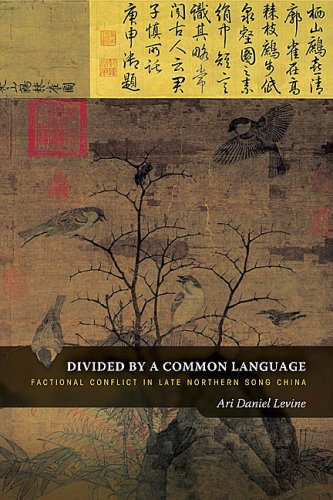

Most ebook files are in PDF format, so you can easily read them using various software such as Foxit Reader or directly on the Google Chrome browser.
Some ebook files are released by publishers in other formats such as .awz, .mobi, .epub, .fb2, etc. You may need to install specific software to read these formats on mobile/PC, such as Calibre.
Please read the tutorial at this link. https://ebooknice.com/page/post?id=faq
We offer FREE conversion to the popular formats you request; however, this may take some time. Therefore, right after payment, please email us, and we will try to provide the service as quickly as possible.
For some exceptional file formats or broken links (if any), please refrain from opening any disputes. Instead, email us first, and we will try to assist within a maximum of 6 hours.
EbookNice Team

Status:
Available4.3
14 reviews
ISBN 10: 0824832663
ISBN 13: 978-0824832667
Author: Ari Daniel Levine
Between 1044 and 1104, ideological disputes divided China’s sociopolitical elite, who organized into factions battling for control of the imperial government. Advocates and adversaries of state reform forged bureaucratic coalitions to implement their policy agendas and to promote like-minded colleagues. During this period, three emperors and two regents in turn patronized a new bureaucratic coalition that overturned the preceding ministerial regime and its policies. This ideological and political conflict escalated with every monarchical transition in a widening circle of retribution that began with limited purges and ended with extensive blacklists of the opposition.
Divided by a Common Language is the first English-language study to approach the political history of the late Northern Song in its entirety and the first to engage the issue of factionalism in Song political culture. Ari Daniel Levine explores the complex intersection of Chinese political, cultural, and intellectual history by examining the language that ministers and monarchs used to articulate conceptions of political authority. Despite their rancorous disputes over state policy, factionalists shared a common repertoire of political discourses and practices, which they used to promote their comrades and purge their adversaries. Conceiving of factions in similar ways, ministers sought monarchical approval of their schemes, employing rhetoric that imagined the imperial court as the ultimate source of ethical and political authority.
Factionalists used the same polarizing rhetoric to vilify their opponents―who rejected their exclusive claims to authority as well as their ideological program―as treacherous and disloyal. They pressured emperors and regents to identify the malign factions that were spreading at court and expel them from the metropolitan bureaucracy before they undermined the dynastic polity. By analyzing theoretical essays, court memorials, and political debates from the period, Levine interrogates the intellectual assumptions and linguistic limitations that prevented Northern Song politicians from defending or even acknowledging the existence of factions. From the Northern Song to the Ming and Qing dynasties, this dominant discourse of authority continued to restrain members of China’s sociopolitical elite from articulating interests that acted independently from, or in opposition to, the dynastic polity.
Deeply grounded in both primary and secondary sources, Levine’s study is important for the clarity and fluidity with which it presents a critical period in the development of Chinese imperial history and government.
🔹 Main Idea:
During the late Northern Song dynasty, factional conflicts split the political elite into competing ministerial coalitions. These factions vied for control over policy-making and bureaucratic appointments at the imperial court in Kaifeng. Although emperors held final approval over decisions, real executive authority often rested with state councilors. Prior to the 1060s, emperors tried to mediate factional rivalries, but the situation escalated into open conflict later on.
🔹 Main Idea:
Northern Song political theorists were constrained by traditional intellectual frameworks. Their understanding of “faction” was shaped by classical hermeneutics (interpretation of Confucian texts) and historical analogism (using historical precedents to interpret the present). These frames provided shared vocabularies and legitimized political discourse.
🔹 Main Idea:
Faction accusations became tools of political manipulation. Fan Zhongyan’s reformist group, active since the 1030s, was labeled a faction by opponents. Since definitions of "faction" were subjective and rhetorical, they were used opportunistically to sway imperial judgment and eliminate rivals.
🔹 Main Idea:
Wang Anshi led the reformist coalition under Emperor Shenzong, using factional rhetoric to justify reforms and discredit opponents. In this period, factional language was deeply tied to arguments about state policy, especially regarding border security and historical destiny.
🔹 Main Idea:
After the reformists lost power in 1085, the antireformists dominated court politics. Reformists like Cai Que faced literary and moral inquisition-style persecution. Even as reformist influence waned, rhetorical attacks against them intensified, portraying them as disloyal and dangerous.
🔹 Main Idea:
Factional justice became retaliatory. In 1097, a Censorate investigation targeted former antireform leaders using charges similar to those used against reformers a decade earlier. Factional rhetoric became a tool of political revenge, highlighting the cycle of power and retribution.
🔹 Main Idea:
The book concludes by examining how rhetorical strategies shaped political authority in the Northern Song. Monarchs from Shenzong to Huizong aligned themselves with specific ideological factions. Language became a weapon to justify political agendas and build loyalty within the bureaucracy.
divided by a common language by meenakshi mukherjee
we are divided by a common language
dividing by common factors calculator
divided by a common language by meenakshi mukherjee pdf
Tags: Ari Daniel Levine, Divided by a Common, Factional Conflict